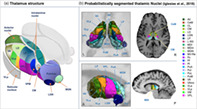- Record: found
- Abstract: found
- Article: found
Probabilistic mapping of thalamic nuclei and thalamocortical functional connectivity in idiopathic generalised epilepsy

Read this article at
Abstract
It is well established that abnormal thalamocortical systems play an important role in the generation and maintenance of primary generalised seizures. However, it is currently unknown which thalamic nuclei and how nuclear‐specific thalamocortical functional connectivity are differentially impacted in patients with medically refractory and non‐refractory idiopathic generalised epilepsy (IGE). In the present study, we performed structural and resting‐state functional magnetic resonance imaging (MRI) in patients with refractory and non‐refractory IGE, segmented the thalamus into constituent nuclear regions using a probabilistic MRI segmentation method and determined thalamocortical functional connectivity using seed‐to‐voxel connectivity analyses. We report significant volume reduction of the left and right anterior thalamic nuclei only in patients with refractory IGE. Compared to healthy controls, patients with refractory and non‐refractory IGE had significant alterations of functional connectivity between the centromedian nucleus and cortex, but only patients with refractory IGE had altered cortical connectivity with the ventral lateral nuclear group. Patients with refractory IGE had significantly increased functional connectivity between the left and right ventral lateral posterior nuclei and cortical regions compared to patients with non‐refractory IGE. Cortical effects were predominantly located in the frontal lobe. Atrophy of the anterior thalamic nuclei and resting‐state functional hyperconnectivity between ventral lateral nuclei and cerebral cortex may be imaging markers of pharmacoresistance in patients with IGE. These structural and functional abnormalities fit well with the known importance of thalamocortical systems in the generation and maintenance of primary generalised seizures, and the increasing recognition of the importance of limbic pathways in IGE.
Abstract
We report that patients with idiopathic generalised epilepsy have different patterns of thalamic structural and functional connectivity alterations depending on whether they are refractory or not to anti‐seizure medication. Only refractory patients showed evidence of atrophy of the anterior (limbic) thalamic nuclei and increased functional connectivity between the ventral lateral posterior nuclei and cortex bilaterally.
Related collections
Most cited references141
- Record: found
- Abstract: not found
- Article: not found
Controlling the False Discovery Rate: A Practical and Powerful Approach to Multiple Testing
- Record: found
- Abstract: found
- Article: not found
